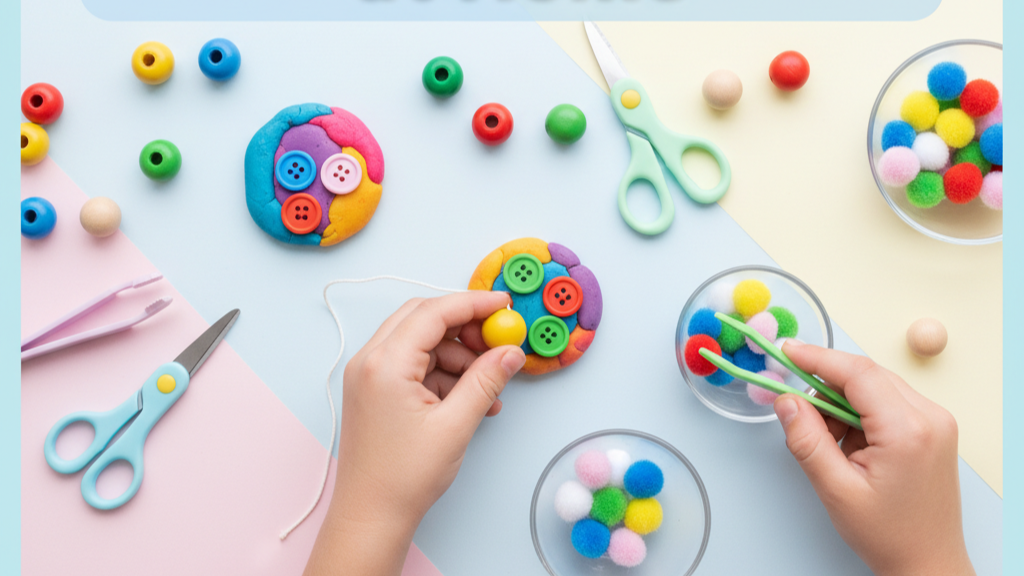Fine Motor Activities for Kids: 15 At-Home Exercises | Kideos Station

15 easy fine motor activities for kids at home to build finger strength & hand coordination. Fun, low-prep exercises for ages 2-8. Expert tips included.

Fine Motor Activities for Kids: 15 At-Home Exercises to Boost Hand Coordination
Fine motor activities for kids are essential for developing finger strength, hand-eye coordination, and independence in daily tasks. Whether you’re looking to support your child’s development or prepare them for school, these fine motor activities can be done right at home with minimal preparation.
This comprehensive guide includes 15 proven fine motor activities for kids that are perfect for children aged 2–8 years. Each activity strengthens the small muscles in hands and fingers, improving skills like writing, buttoning, cutting, and drawing. The best part? Most require only items you likely already have at home!
Table of Contents
Why Fine Motor Skills Matter for Child Development
Fine motor skills involve coordinated movements of small muscles in the hands and fingers. These skills are critical for everyday tasks and academic success. According to the American Academy of Pediatrics, strong fine motor development is linked to better school performance and increased confidence.
Fine motor activities for kids help develop:
- Correct pencil grip – Essential for proper writing and reducing hand fatigue
- Neat handwriting – Better control leads to improved legibility
- Scissor skills – Important for craft projects and school activities
- Buttoning and zipping – Supports independence in dressing
- Hand-eye coordination – Improves focus and precision in tasks
- Finger muscle strength – Builds endurance for detailed work
- Pincer grip development – Strengthens the thumb-and-finger grasp used for writing
Research from the CDC’s developmental milestones shows that children who engage in regular fine motor activities reach writing milestones faster and experience fewer learning challenges.
15 Best Fine Motor Activities for Kids at Home
These fine motor activities for kids require minimal setup and use everyday household items. Start with activities that match your child’s age and skill level, then gradually progress to more challenging ones.
1. Playdough Pinching & Rolling – Essential Fine Motor Exercise
One of the most effective fine motor activities for kids, playdough builds finger muscle strength and improves overall hand control through creative play.
- Pinch small balls from playdough
- Roll snakes and thin strands
- Cut shapes with plastic scissors
- Flatten circles using palm pressure
- Press small objects into the dough
Age: 2-8 years | Duration: 15-20 minutes
2. Bead Stringing – Precision & Focus Builder
Bead stringing is an excellent fine motor activity for kids that improves pincer grip, hand-eye coordination, and patience.
- Use large beads (1+ inch) for younger children
- Use thick string or shoelaces as threading material
- Challenge kids to create patterns
- Sort beads by color before stringing
Age: 3-8 years | Duration: 20-30 minutes
3. Tweezers Transfer Challenge
Transfer pom-poms, cotton balls, or small toys between bowls using tweezers—a fantastic fine motor activity that improves precision and control.
- Start with large pom-poms (1 inch diameter)
- Gradually progress to smaller items
- Time the activity as a fun race
- Use tweezers in different grip positions
Age: 3-7 years | Duration: 10-15 minutes
4. Sticker Peeling & Placement
Sticker activities are perfect for younger children just starting fine motor skill development. This activity builds finger isolation and hand strength.
- Peel stickers from sheets slowly
- Place stickers on large areas first
- Create pictures or patterns with stickers
- Use stickers to decorate craft projects
Age: 2-5 years | Duration: 10-20 minutes
5. Coin & Bottle Cap Sorting
Sorting activities combine fine motor practice with cognitive skills. This activity boosts observation abilities while strengthening hands.
- Sort coins or caps by size and color
- Place small items into containers
- Use tongs or tweezers for picking up items
- Create patterns with sorted objects
Age: 2-8 years | Duration: 15-25 minutes
6. Guided Cutting Practice
Scissor skills are crucial fine motor milestones. Use thick paper strips with dotted lines for guided, safe cutting practice.
- Start with pre-cut strips (½ inch wide)
- Follow dotted lines for guidance
- Progress to cutting shapes and pictures
- Use child-safe scissors with rounded tips
Age: 3-8 years | Duration: 15-20 minutes
7. Buttoning & Zipping Board
Create a practice board with old clothing items. This practical fine motor activity teaches real-life dressing skills while building hand strength.
- Collect old shirts with buttons
- Add zippers, snaps, and velcro
- Mount items on a board for easy access
- Practice regularly to build mastery
Age: 3-8 years | Duration: 10-15 minutes
8. Pasta Threading on Spaghetti
An exciting balance and fine motor activity challenge that combines hand coordination with fun experimentation.
- Use dry pasta with large holes (penne, rigatoni)
- Use uncooked spaghetti as the threading material
- Try threading onto wooden skewers
- Create tall towers or patterns
Age: 3-8 years | Duration: 15-25 minutes
9. Clothespin Grip Strengthening
Clipping clothespins improves finger strength and hand coordination through repeated, functional movements.
- Clip clothespins along paper edges
- Create patterns with colored clothespins
- Clip items to a clothesline
- Use in sorting games by color
Age: 3-8 years | Duration: 12-18 minutes
10. Pom-Pom Drop Tubes
Stick cardboard tubes to walls and drop pom-poms through them—a visually engaging fine motor activity that develops hand control.
- Attach paper towel tubes vertically
- Drop pom-poms through the tubes
- Collect and repeat multiple times
- Try aiming from increasing distances
Age: 2-6 years | Duration: 10-20 minutes
11. Rice Sensory Bin Scooping
Scooping and pouring rice develops hand control and fine motor coordination through sensory exploration.
- Fill a container with uncooked rice
- Use small spoons and cups for scooping
- Practice pouring from one container to another
- Hide small objects for discovery and fine motor retrieval
Age: 2-6 years | Duration: 15-25 minutes
12. Spray Bottle Finger Control
Spraying water targets finger strength and hand stability—perfect for outdoor or bathroom play with fine motor benefits.
- Use spray bottles with easy-to-press triggers
- Spray targets (drawings, trees, chalk)
- Practice pressing and releasing gradually
- Build hand strength over repeated sessions
Age: 3-8 years | Duration: 15-20 minutes
13. Q-Tip Dot Painting
Dot painting with Q-tips is an artistic fine motor activity that improves grip strength and precision in a creative format.
- Dip Q-tips in washable paint
- Create dot patterns on paper
- Fill in dotted outlines or templates
- Make nature scenes with dots
Age: 2-8 years | Duration: 15-30 minutes
14. LEGO & Building Block Construction
Building with LEGO bricks combines creativity with essential fine motor practice—excellent for hand dexterity development.
- Start with larger DUPLO blocks for younger children
- Progress to standard LEGO for older kids
- Follow building instructions for challenge
- Create free-form structures and designs
Age: 2-8 years | Duration: 20-40 minutes
15. Button Pattern Matching & Sorting
Button activities improve visual memory and fine motor control while creating beautiful patterns and designs.
- Collect buttons of various sizes and colors
- Create pattern templates on paper
- Match buttons to templates
- Glue buttons to create mosaics
Age: 3-8 years | Duration: 15-25 minutes
Daily Practice Recommendations for Fine Motor Skill Development
For optimal development: Engage in 15–20 minutes of fine motor activities daily. Rotate activities every 2–3 days to build multiple skill sets and keep children engaged and motivated.
Research from occupational therapy specialists shows that consistent, varied practice produces the best results. Here’s a sample weekly schedule:
| Day | Activity | Duration | Target Skill |
|---|---|---|---|
| Monday | Playdough Pinching | 15 min | Finger Strength |
| Tuesday | Bead Stringing | 20 min | Precision & Focus |
| Wednesday | Tweezers Transfer | 15 min | Pincer Grip |
| Thursday | Scissor Practice | 18 min | Hand-Eye Coordination |
| Friday | Q-Tip Painting | 20 min | Grip & Control |
| Saturday | LEGO Building | 30 min | Dexterity & Creativity |
| Sunday | Rice Bin Play | 20 min | Hand Control |
Comparison: Best Fine Motor Tools & Supplies
When choosing materials for fine motor activities for kids, consider your child’s age, interests, and skill level. Here’s a comparison of the most effective tools:
| Tool/Material | Primary Benefit | Best Age Range | Cost |
|---|---|---|---|
| Playdough | Strengthens finger muscles & creativity | 2–8 years | Budget-Friendly |
| Beads & String | Enhances hand-eye coordination & focus | 3–8 years | Budget-Friendly |
| Tweezers | Improves pincer grip & precision | 3–7 years | Budget-Friendly |
| Child-Safe Scissors | Develops cutting & coordination skills | 3–8 years | Budget-Friendly |
| Clothing Buttons/Zippers | Builds practical dressing independence | 3–8 years | Free (Repurposed) |
| LEGO Bricks | Combines motor skills with creativity | 2–12 years | Moderate |
Expert Resources & Research on Fine Motor Development
For more information on fine motor skill development, consult these authoritative sources:
- American Academy of Pediatrics (AAP) – Comprehensive developmental guidelines and milestones
- CDC’s Learn the Signs – Act Early Program – Developmental milestone tracking
- American Occupational Therapy Association (AOTA) – Professional OT resources and guidelines
- National Association for the Education of Young Children (NAEYC) – Early childhood education standards
Frequently Asked Questions About Fine Motor Activities
1. What exactly are fine motor skills?
Fine motor skills involve small, precise movements of hands and fingers used for writing, drawing, buttoning, and other detailed tasks. They develop gradually from infancy through early childhood and require practice to master.
2. Which fine motor activity is best for beginners?
The best starting activities include playdough, sticker peeling, scooping rice, and bead stringing. These require minimal coordination and build confidence while strengthening hands.
3. When should I start introducing fine motor activities for kids?
Children can begin simple fine motor activities from around 18 months. Start with large, easy-to-manipulate objects and gradually introduce more challenging activities as they grow.
4. How long does it take to see improvements in fine motor skills?
With consistent daily practice, most children show noticeable improvements within 4-6 weeks. However, individual development varies, and patience is essential.
5. Can I do fine motor activities indoors and outdoors?
Absolutely! Many activities can be adapted for outdoor play—spray bottle activities, chalk drawing, water play, and sensory bin activities all work well outdoors.
6. What if my child is struggling with fine motor skills?
If you notice significant delays, consult your pediatrician. They may refer you to an occupational therapist who can provide professional assessment and targeted intervention.
Discover More Kids Learning & Development Content
Explore our complete collection of parenting guides and learning activities:
- 46 Daily Questions: Why Kids Ask & How to Answer
- YouTube Kids Videos: Safe, Trending & How to Use Them
- Kids Sleep Problems: 9 Expert Solutions That Actually Work
- Kids Clothing Online: Fashion & Quality Essentials
- Educational Kids Toys Online: Fun Learning Tools
Follow Kideos Station for daily parenting tips, learning hacks, and expert child development advice!

